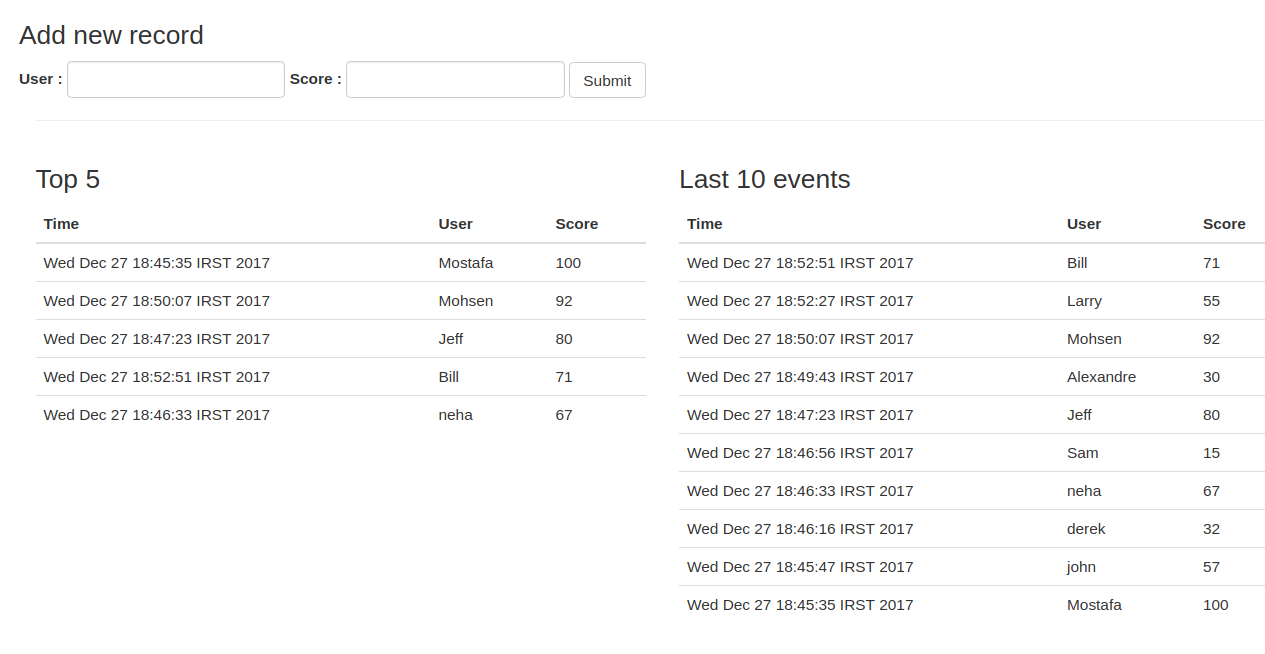Last week I decided to dirty my hands with Kafka Streams. I wanted to write simple application with Kafka Streams more interesting than World Count. I decided to write a program that calculates top 5 using Kafka Streams. Imagine you have written a game, and you want to display top 5 users. You also need that calculating and displaying top 5 to be real time. You need whenever a user has hit a record, it automatically displays user record. This is how application look like:

We can harness the Kafka streams reactive nature and Server-Sent Events to build real time web application.Let’s dive into the implementation.
Implementation details
First of all you need a topic for storing each record. Whenever a user got a score, whether it is a record or not, you store this record to this topic. This topic act a single source of truth:
./kafka-topics.sh --create --topic scores --replication-factor 2 --partitions 1 --zookeeper localhost:2181
The only point is that I set partitions to one, because I wanted to maintain ordering of messages. You can change replication factor to any number you want. Besides this topic, we need another topic for storing High Scores. This topic stores each user score if and only if, user has hit a record. Here is defination:
./kafka-topics.sh --create --topic high-scores --replication-factor 2 --partitions 1 --zookeeper localhost:2181 --config cleanup.policy=compact
The only difference moreover topic name is that we set cleanup.policy=compact. This is necessary because we want Kafka stores all messages in this topic, and deletes a record only when new record with the same key arrived. So if a user hit a record, Kafka automatically delete his last record from this topic. For more information see Log compacction.
Kafka Streams
To find out top score for each user using Kafka streams, we can write (HighScoreStreams.java ):
KStream<String, Integer> scores = builder.stream("scores", Consumed.with(Serdes.String(), Serdes.Integer()));
KTable<String, Integer> highScores = builder.table("high-scores", Consumed.with(Serdes.String(), Serdes.Integer(),new FailOnInvalidTimestamp(), Topology.AutoOffsetReset.EARLIEST));
scores.leftJoin( highScores , (v1,v2) -> {
//this is the first time user has submitted his/her score, so there is no record for this user in 'high-scores' topic
if(v2 == null){
return v1;
}
//user has hit his/hre record
if( v1 > v2 ) {
return v1;
}
//this value is not a record, we return null but we don't send null values to 'high-scores' topic
return null;
})
.filter( (k,v) -> v != null ) //filter null values
.to( "high-scores" , Produced.with(Serdes.String(),Serdes.Integer()));
I used builder.stream for scores topic but builder.table for high-scores beacuse I only want the last record of a user, not a history of his records. With this code, high-scores topic contains the high score of all users.
Top 5
For calculating top 5, I wrote a simple Kafka consumer (HighScores.java), that constantly read from high-scores topic, and add high scores to a ArrayList with maximum size of 5. Whenever this list changes, I send it through SSE to the clients(HttpServer.java):
get("/highScores", (req, res) -> {
res.header("Content-Type", "text/event-stream");
res.header("Cache-Control", "no-cache");
PrintWriter writer = new PrintWriter(res.raw().getOutputStream());
HighScores highScores = new HighScores();
Iterator<List<Score>> iterator = highScores.iterator();
while (iterator.hasNext()) {
List<Score> scores = iterator.next();
writer.write("data: " + toJson(scores) + "\n\n");
writer.flush();
}
return "";
});
Client side
On client side(home.html), I use EventSource to stablish a connection to SSE server and update DOM, whenever a new event has arrived:
$(document).ready(function () {
var source = new EventSource("/highScores");
source.onmessage = function (event) {
var data=JSON.parse(event.data);
document.getElementById("tblHighScores").innerHTML = "";
for(var i = data.length-1; i >= 0; i--) {
document.getElementById("tblHighScores").innerHTML += "<tr><td>" + data[i].time + "</td><td>" + data[i].user + "</td><td>" + data[i].score + "</td></tr>";
}
};
});
That’s it. You can find the full source code here.